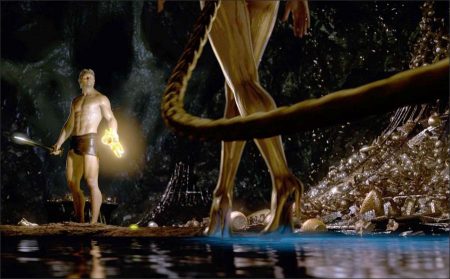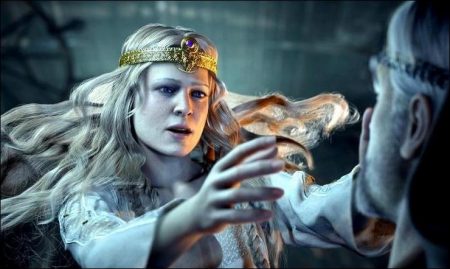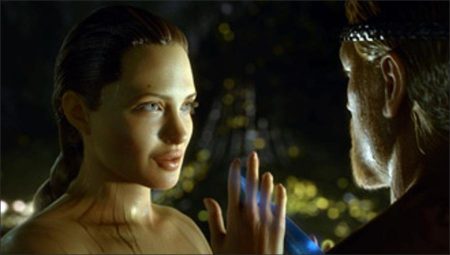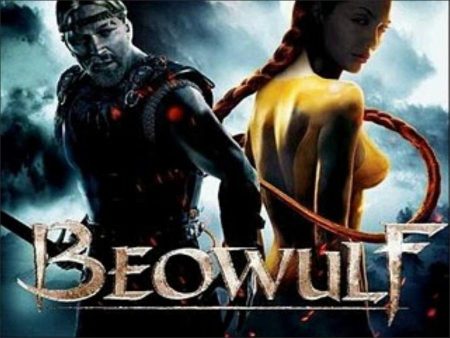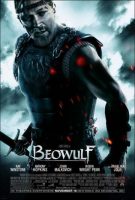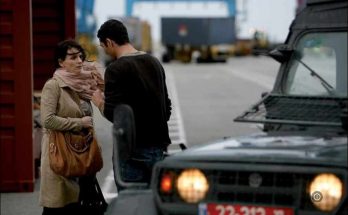Taglines: Face your demons.
In the age of heroes comes the mightiest warrior of them all, Beowulf. After destroying the overpowering demon Grendel, he incurs the undying wrath of the beast’s ruthlessly seductive mother, who will use any means possible to ensure revenge. The ensuing epic battle resonates throughout the ages, immortalizing the name of Beowulf.
Academy Award-winning director Robert Zemeckis tells the oldest epic tale in the English language with the most modern technology, advancing the cinematic form through the magic of digitally enhanced live-action. Unlike anything you will see, “Beowulf” represents a decade long quest for New York Times bestselling author Neil Gaiman (the graphic novels Mirrormask and Sandman), and Academy Award-winning screenwriter Roger Avary (“Pulp Fiction”) to see the myth adapted to the big screen. With Real D, Dolby Digital 3D and IMAX 3D “Beowulf” delivers an unparalleled immersive experience that transports you to the age of heroes.
Set in a magical era veiled by the mists of time, replete with heroes and monsters, adventure and valor, gold and glory, one exceptional man, Beowulf, emerges to save an ancient Danish kingdom from annihilation by an ungodly creature. In return, this legendary six foot-six-inch Viking, brimming with daring confidence and ambition, succeeds to the throne.
A Heroic Epic for the Ages
The name Beowulf resounds throughout the kingdom and songs are sung of his exceptional prowess and deeds after he comes to the rescue of King Hrothgar, whose kingdom has been devastated by Grendel, a ruthless monster who has tortured and devoured its residents, leaving them in a constant state of panic and fear.
In ridding the kingdom of this savage beast, Beowulf gains fame and fortune for himself. Great riches and overwhelming temptations are thrown at him. How wisely he chooses to handle his newfound power will forever define his fate as a warrior, a champion, a leader, a husband and, most importantly, as a man.
Beowulf is the oldest surviving epic poem in the English language. While Robert Zemeckis’ film adaptation contains many of the poem’s characters and themes — great monsters and heroes, the eternal conflict between good and evil, and a layered exploration of the nature of valor and glory — it is definitely not your high school teacher’s Beowulf.
“Frankly, nothing about the original poem appealed to me. I remember being assigned to read it in junior high school and not being able to understand it because it was in Old English,” admits Zemeckis. “It was one of those horrible assignments. I never really thought about it after that, never considered that it might make for an interesting story. But when I read the screenplay that Neil Gaiman and Roger Avary did, I was immediately captivated. I asked them, `What is it about this screenplay that makes this story so fascinating when the poem, to me, was so boring?’
And their answer was, `Well, let’s see, the poem was written somewhere between the 7th century and the 12th century. But the story had been told for centuries before that. The only people in the 7th century who knew how to write were monks. So, we can assume they did a lot of editing.’ Neil and Roger explored deeper into the text, looking between the lines, questioning the holes in the source material, and adding back what they theorized the monks might have edited out (or added) and why. They managed to keep the essence of the poem but made it more accessible to a modern audience and made some revolutionary discoveries along the way. This should stir some debate in academia.”
As he worked with the writers to develop the story further, Zemeckis became a student of the subject in a way that would make his junior high school teacher proud. “Once I became intrigued by the script, I went back and re-read the poem, talked to Beowulf scholars and immersed myself in the legend. Many of the themes that are in Beowulf were lifted from the Bible — a heroic man’s journey, the fight between good and evil and the price of glory. And you see that Beowulf is the foundation for all our modern heroes, from Conan to Superman to the Incredible Hulk.”
“What’s so attractive about the Beowulf legend is that it is wrapped up in this great action-adventure-mythologicalepic world with monsters and seductresses, creatures that have certainly existed, at least in our subconscious, since ancient times,” adds producer Jack Rapke.
In retrospect, Gaiman and Avary seem the perfect talents for this project. Gaiman, as his biography notes, “…is listed in the Dictionary of Literacy Biography as one of the top ten living post-modern writers and is a prolific creator of prose, poetry, film, journalism, comics, song lyrics and drama.” In particular, Gaiman is beloved by comic book fans for his DC Comics series Sandman, which won nine Will Eisner
Comic Industry Awards and three Harvey Awards; Sandman #19 took the 1991 World Fantasy Award for best short story, making it the first comic ever to win a literary award. Avary is similarly celebrated for his dark, edgy, groundbreaking screenplays and films, including his Oscar winning screenplay for “Pulp Fiction,” (shared with Quentin Tarantino), and his influential cult films as a director, the Cannes Prix très spécial winning “Killing Zoe” and the adaptation of Bret Easton Ellis’ novel The Rules of Attraction.
Gaiman and Avary originally began their collaboration when they decided to work together on a screenplay version of Gaiman’s Sandman. While that project never came to fruition, the two recognized that they were kindred spirits. Nevertheless, adapting the Beowulf poem for the screen proved to be a long, strange and ultimately rewarding trip for Gaiman and Avary.
“Roger and I hit it off during the Sandman process. very much liked him and the way his mind worked,” says Gaiman. “At some point, Roger mentioned to me that he’d always wanted to make Beowulf into a movie, but he’d never been able to work out a way to get from the first two acts to the third, because the structure is such that you begin with Beowulf’s fight, then fighting Grendel’s mother and then move forward 50 years when he fights the dragon. It’s not the normal three-act structure of screenplays. I suggested a few ways that it could work. There was a pause and Roger said, `When are you free?'”
Basically, Neil came up with the key operator of a unified field theory of Beowulf, which I had been working on for a decade.” says Avary. “The poem always seemed disjointed to me and, in particular, Beowulf never seemed to be the most reliable of narrators. For instance, Grendel never attacks Hrothgar; he just torments him. Why? It made me ask the simple question that for some reason no one has ever asked before: who is Grendel’s father? It really plagued me. All of Grendel’s behavior began to make sense when examined in that light. Later, Beowulf tears off Grendel’s arm and Grendel slinks off to his cave to die.
After Grendel’s mother’s retribution, Beowulf ventures into the cave, ostensibly to kill Grendel’s mother. Yet he emerges from the cave with Grendel’s head, not the head of the Mother, which is really perplexing. Beowulf says he killed Grendel’s mother, but we only have his word. Where’s the proof that he killed the mother? It became obvious to me that Beowulf had fallen prey to the same temptations I surmised had befallen Hrothgar — the temptations of a siren. He had made a pact with a demon.
“Then, in the second half of the poem,” Avary continues, “after Beowulf has become king, a dragon attacks him and his kingdom. I couldn’t figure out how this fit into everything. I was telling Neil about my theories, when he made the remarkable insight that the dragon might be Beowulf’s son — his sin comes back to haunt him. Suddenly, the two halves of the Beowulf epic, which had always seemed so disjointed, made perfect story arc sense. Had it been a snake, it would have bit me. It’s quite possible that these elements of the structure had been lost over hundreds of years of verbal telling, and further diluted by the Christian monks who added elements of Christianity when they transcribed it to the parchment we now know as MS Cotton Vitellius A.xv.”
Gaiman and Avary are not the first to notice the awkward construction of the original poem. David Wright points out in the Penguin Classics edition of Beowulf that “… the early critics and commentators of Beowulf and a good many of the later ones have been sarcastic about the clumsiness of the plot. For the poem is a bit of a rag-bag as well, stuffed with fragments from the history of Scandinavian tribes and spilling over with untidy-looking references to apparently irrelevant events and legends.”
Wright also notes that Lord of the Rings creator J.R.R. Tolkien appreciated the poem’s power. In his famous essay, Beowulf: The Monsters and Critics, Tolkien noticed, among other things, that although Beowulf is a superhero of sorts he is, in the end, human and his all-too-human traits contribute to his downfall. “He is a man and that for him and many is sufficient tragedy.”
Zemeckis saw the hero along similar lines. “Our Beowulf is a bit more flawed, more like a human hero than a god. He’s not a Thor character. He is a real person who has a lot of flaws — hubris being chief among them.”
It’s a good bet that Tolkien did not have as much fun as Gaiman and Avary did when writing about their main character. “Roger and I flew down to Mexico and he borrowed a house from a friend for a week,” says Gaiman, “a week of absolute madness. We were surrounded by translations of Beowulf, all the different ones we could find, including some with Old English on one page and the English translation on the other. We hooked up our computers and we wrote like mad. We returned home with a script, one that Bob Zemeckis read and wanted to do.”
Now, with “Beowulf,” Zemeckis was ready to take the technology to the next level. “When you do a performance capture film you have the ability to do two forms of casting, one for performance and one for likeness, which means you can actually separate what a character looks like in the film from the performer who portrays that character,” says Starkey.
“It’s one of the reasons we decided to do the film in this style; for instance, no one on the planet looks like the character Bob envisioned for Beowulf or could perform on the level Bob wanted for this film. Beowulf is bigger than life and there is no single human actor who embodies everything Bob saw in the character. So, how do you blend these two irreconcilable aspects?
By casting the best actor possible and creating that look, a six-foot-six Christ-like image in the computer. The same is true with Grendel. If we were doing Grendel in a traditional film, we would have had a 12-foot puppet on set and created additional computer graphics. In this case, we could get the perfect performer, who portrayed all of Grendel’s pain and suffering but wasn’t limited by prosthetics or uncomfortable suits. If we had shot this film traditionally, we could never have done all that,” Starkey concludes.
“Because it is a mythological fable, the demand for photo reality was not as paramount as it might be,” adds producer Rapke. “Also, to replicate the conceptual visual world Bob envisioned would be almost impossible in the 2D world. Using this process gave us the opportunity to cast whoever we felt was the perfect actor for each part. So, for us, it was the best way to get over certain hurdles and do a lot of things which would have been impossible in a traditional live action format.”
Avary adds that performance capture realized the film the way he had always envisioned it and, in addition, it presented an almost limitless canvas. “The interesting thing to me was that the performance capture process really allowed the film to be performance- based. I had always seen it as a chamber piece — it’s in court, and there’s intrigue between people with their myriad relationships. I always wanted it to be a fully formed, emotional experience. I also remember Bob saying, `C’mon, guys, do whatever you want — when Beowulf fights the dragon, let’s really have him fight the dragon.’ We weren’t restricted by anything, so Neil and I were able to write without the shackles we’d normally have on a film,” Avary notes.
Continue Reading and View the Theatrical Trailer
Beowulf (2007)
Directed by: Robert Zemeckis
Starring: Angelina Jolie, Anthony Hopkins, Ray Winstone, John Malkovich, Brendan Gleeson, Dominic Keating, Alison Lohman, Robin Wright Penn, Charlotte Salt, Julene Renee, Leslie Zemeckis
Screenplay by: Roger Avary
Production Design by: Doug Chiang
Cinematography by: Robert Presley
Film Editing by: Jeremiah O’Driscoll
Costume Design by: Gabriella Pescucci
Set Decoration by: Karen O’Hara
Art Direction by: Norman Newberry, Greg Papalia
Music by: Alan Silvestri
MPAA Rating: PG-13 for intense sequences of violence including disturbing images, some sexual material and nudity.
Distributed by: Paramount Pictures
Release Date: November 17, 2007
Views: 122
